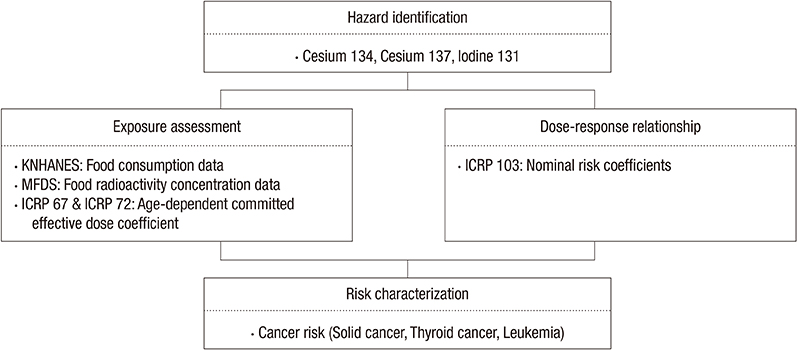J Korean Med Sci.
2016 Jan;31(1):9-12. 10.3346/jkms.2016.31.1.9.
Estimates of Radiation Doses and Cancer Risk from Food Intake in Korea
- Affiliations
-
- 1Department of Preventive Medicine, Korea University College of Medicine, Seoul, Korea. leewj@korea.ac.kr
- 2Department of Planning and Research for Radiological Emergency, Korea Institute of Radiological and Medical Sciences, Seoul, Korea.
- 3Department of Radiation Safety, Korea Institute of Nuclear Safety, Daejeon, Korea.
- 4Department of Food Safety Evaluation, National Institute of Food & Drug Safety Evaluation, Ministry of Food and Drug Safety, Cheongju, Korea.
- 5Division of Food and Environmental Sciences, Wonkwang University, Iksan, Korea.
- KMID: 2359985
- DOI: http://doi.org/10.3346/jkms.2016.31.1.9
Abstract
- The aim of this study was to estimate internal radiation doses and lifetime cancer risk from food ingestion. Radiation doses from food intake were calculated using the Korea National Health and Nutrition Examination Survey and the measured radioactivity of 134Cs, 137Cs, and 131I from the Ministry of Food and Drug Safety in Korea. Total number of measured data was 8,496 (3,643 for agricultural products, 644 for livestock products, 43 for milk products, 3,193 for marine products, and 973 for processed food). Cancer risk was calculated by multiplying the estimated committed effective dose and the detriment adjusted nominal risk coefficients recommended by the International Commission on Radiation Protection. The lifetime committed effective doses from the daily diet are ranged 2.957-3.710 mSv. Excess lifetime cancer risks are 14.4-18.1, 0.4-0.5, and 1.8-2.3 per 100,000 for all solid cancers combined, thyroid cancer, and leukemia, respectively.
Keyword
MeSH Terms
-
Adolescent
Adult
Cesium Radioisotopes/chemistry
Child
Child, Preschool
*Eating
Food Contamination, Radioactive/*analysis
Humans
Infant
Infant, Newborn
Iodine Radioisotopes/chemistry
Neoplasms, Radiation-Induced/*etiology
Nutrition Surveys
Radiation Dosage
Republic of Korea
Young Adult
Cesium Radioisotopes
Iodine Radioisotopes
Figure
Reference
-
1. Murakami M, Oki T. Estimation of thyroid doses and health risks resulting from the intake of radioactive iodine in foods and drinking water by the citizens of Tokyo after the Fukushima nuclear accident. Chemosphere. 2012; 87:1355–1360.2. Kamada N, Saito O, Endo S, Kimura A, Shizuma K. Radiation doses among residents living 37 km northwest of the Fukushima Dai-ichi Nuclear Power Plant. J Environ Radioact. 2012; 110:84–89.3. Harada KH, Niisoe T, Imanaka M, Takahashi T, Amako K, Fujii Y, Kanameishi M, Ohse K, Nakai Y, Nishikawa T, et al. Radiation dose rates now and in the future for residents neighboring restricted areas of the Fukushima Daiichi Nuclear Power Plant. Proc Natl Acad Sci U S A. 2014; 111:E914–E923.4. Fisher NS, Beaugelin-Seiller K, Hinton TG, Baumann Z, Madigan DJ, Garnier-Laplace J. Evaluation of radiation doses and associated risk from the Fukushima nuclear accident to marine biota and human consumers of seafood. Proc Natl Acad Sci U S A. 2013; 110:10670–10675.5. Brown J. Assessment of radiation doses in the UK from the Fukushima Daiichi Nuclear accident. J Radiol Prot. 2014; 34:N41–N46.6. McGinnity P, Currivan L, Duffy J, Hanley O, Kelleher K, McKittrick L, O'Colmain M, Organo C, Smith K, Somerville S, et al. Assessment of the Impact on Ireland of the 2011 Fukushima Nuclear Accident. Dublin: Radiological Protection Institute of Ireland (Ireland);2012.7. Kim CK, Byun JI, Chae JS, Choi HY, Choi SW, Kim DJ, Kim YJ, Lee DM, Park WJ, Yim SA, et al. Radiological impact in Korea following the Fukushima nuclear accident. J Environ Radioact. 2012; 111:70–82.8. IAEA. Assessment of doses to the public from ingested radionuclides. IAEA Safety Reports Series No.14, STI/PUB/1067. Vienna: 1999.9. Kweon S, Kim Y, Jang MJ, Kim Y, Kim K, Choi S, Chun C, Khang YH, Oh K. Data resource profile: the Korea National Health and Nutrition Examination Survey (KNHANES). Int J Epidemiol. 2014; 43:69–77.10. Ministry of Food and Drug Safety. Risk assessment of heavy metals in infant & young children foods. Daejeon: Ministry of Food and Drug Safety;2012.11. ICRP. Age-dependent doses to members of the public from intake of radionuclides - Part 2 Ingestion dose coefficients. ICRP Publication 67. Ann ICRP. 1993; 23(3-4):12. ICRP. Age-dependent doses to the members of the public from intake of radionuclides - Part 5 Compilation of ingestion and inhalation coefficients. ICRP Publication 72. Ann ICRP. 1995; 26(1):13. Statistics Korea. Population projections for Korea, Life expectancy at birth (Korea). 2015. accessed on 17 March 2015. Available at http://kosis.kr/.14. The 2007 Recommendations of the International Commission on Radiological Protection. ICRP publication 103. Ann ICRP. 2007; 37(2-4):15. National Cancer Center Korea. Attrubutable causes of cancer in Korea in the year 2009. accessed on 17 March 2015. Available at http://www.ncc.re.kr/.16. JFA. Leakage of comtaminated water at TEPCO's Fukushima Daiichi nuclear power station and the safety of fishery products. Japan Fisheries Agency;2014. accessed on 17 March 2015. Available at http://www.jfa.maff.go.jp/e/index.html.17. Evangeliou N, Balkanski Y, Cozic A, Møller AP. Global and local cancer risks after the Fukushima Nuclear Power Plant accident as seen from Chernobyl: a modeling study for radiocaesium ((134)Cs&(137)Cs). Environ Int. 2014; 64:17–27.
- Full Text Links
- Actions
-
Cited
- CITED
-
- Close
- Share
- Similar articles
-
- Citrus Fruit Intake and Breast Cancer Risk: A Quantitative Systematic Review
- A Study on Nausea & Vomiting, Anorexia and Food intake in Cancer Patients undergoing Chemotherapy Overtime: Comparison between Cervix Cancer and Stomach Cancer
- A Study on Patterns of Dose for Radiation Workers in Korea
- The Nutritional Intakes of the Stomach Cancer Patients in the Daegu and Gyeongbuk Areas, Korea
- Breast Cancer Risk and Dietary Factor: A Case-Control Study


